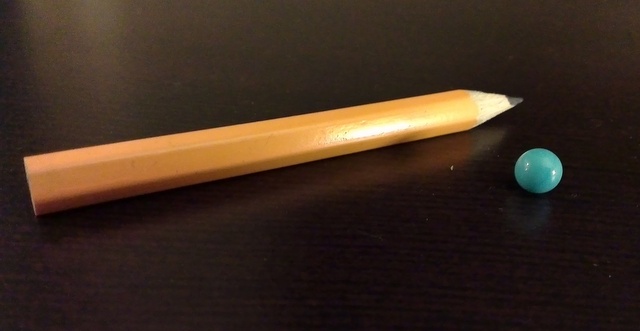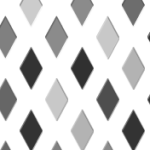This illusion concerns apparent rotation generated by pure translation. Square patterns consisting of four segments appear to rotate when they move straightly at a constant speed across the grid background. More surprisingly, the rotations in opposite directions can be generated by exactly the same square patterns. This illusion might be explained by well-known inchworm illusion; inchworm illusion arises at the four segments one after another resulting in the impression of rotation. This illusion is new in the sense that the rotation is generated by pure
translation.
Through the Eyes of Giants

If a giant whose eyes are 200 yards apart look down at your city, how would the city appear to him? We boarded a Cessna and took areal photographs of Boston from viewing points hundreds of yards apart, then converted the shots to anaglyphs. Using 3D glasses, you can now experience Boston through the eyes of a giant. This way, you perceive the city as a miniature 3D model of Boston; a city that is tiny compared to your head size but has all the details of a real city.
Three-fold cubes: An object whose form can be interpreted in three different ways
Modern brain imaging techniques are allowing scientists to peer into the workings of the brain as never before. Such studies require visual stimuli whose impact on brain activity can be tracked amongst the hubbub of other thoughts. Ambiguous figures are important in this regard because although the stimulus does not change, the viewer’s mental image does; providing a stimulus-independent link to conscious experience. Although ambiguous figures generally offer two interpretations, they can offer more. Stimuli producing three interpretations are rare, but of especial interest because they provide a more exacting test of what is happening in our brains when perceptions switch.
The Knobby Sphere Illusion

To experience ‘the knobby sphere illusion’ you will need one pencil and a small round hard sphere. Squeeze the pencil lengthwise very hard between your thumb and first finger for 60 seconds, making a deep indentation in the skin. Now feel the ball bearing at the location of the indentation by rolling around in the skin indentation. It no longer feels round, but instead feels like it has rounded corners, as if the ball were in fact sort of hexagonal in cross-section. This is because the brain assumes the receptor sheet is flat, and misattributes the ‘cornerness’ to the ball.
Bottom-line: Deforming the receptor sheet leads to misperceiving the shape of objects.
The Disappearing Smoke – Disappearing Pleasure!

People don’t do what they don’t like. So we ask: If smokers cannot see themselves smoking, how would that affect their other senses? Our illusion project demonstrates how just the loss of sight can negatively affect the emotional pleasure a smoker derives from smoking. Just like Pavlov’s experiments, when a smoker sees smoke, it triggers pleasurable emotional responses based on their past memories of smoking, even before the nicotine enters their body. With the appropriate protocol, if the smoke is not seen, just like magic, the pleasure disappears. This protects people from the addictiveness of nicotine, no pleasure means no addiction!
Dancing Diamond

See the illusion
Although the diamonds and patterns in the illusion seem to shift and move about, in reality this is illusory. The diamond edges do not change as their fills are cycled between dark and light where the sense of movement is amplified by changes in lightness and configuration as the ‘whole’ is viewed rather than individual parts. You can explore how different factors interact and affect the illusion of movement by using the controls to change edges, background luminance, size and orientation and see an interesting version of the illusion by pressing the ‘Gestalt-z Waltz’ link.
The Coyote Illusion: Motion Blur Increases Apparent Speed
Cartoonists are known to use multiple illustrative techniques to depict fast moving objects. In the Road Runner and Wile E. Coyote Show, for example, cartoonists drew multiple numbers of feet, usually streaky and blurred inside distorted loops under the cartoon characters’ torsos to symbolize rapid motion. Our illusion demonstrates that the perceived speed of objects can go twice as fast as their actual speed when objects getting blur while that are revolving rapidly in circular paths. This finding supports the view that the human brain uses many strategies to estimate speed of moving objects in the environment.
Dynamic Size Contrast Illusion
The size of a moving object can be radically misperceived when the viewer”s eyes are moving and the background against which it is moving is itself changing size. When the background is growing the object will appear to shrink. Conversely, when the background is shrinking the object will appear
to grow.
Rotating by Scaling
We know from experience that rigid objects can rotate and move but not stretch. A human head is considered to be a rigid object, and therefore is not expected to spontaneously change its shape. This expectation allows us to create the illusion of a head rotating around a vertical axis.
By dividing the 3 dimensional model of a head into left and right hemisphere components, a rotation effect can be achieved by stretching one side while compressing the other along the horizontal dimension via computer algorithms.
The present illusion reveals an interaction between cognitive assumptions about rigidity and visual perception.
